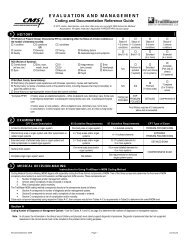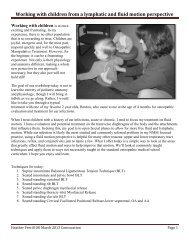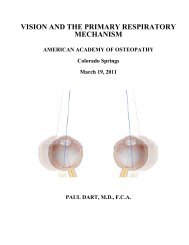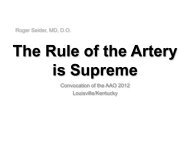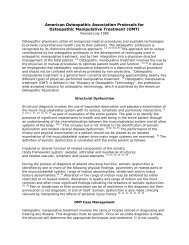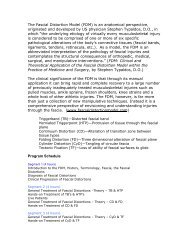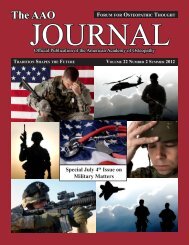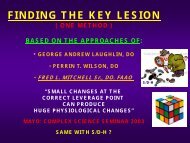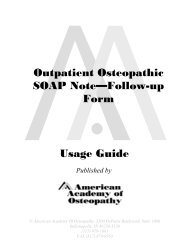(OMT) for Patients with Low Back Pain - American Academy of ...
(OMT) for Patients with Low Back Pain - American Academy of ...
(OMT) for Patients with Low Back Pain - American Academy of ...
You also want an ePaper? Increase the reach of your titles
YUMPU automatically turns print PDFs into web optimized ePapers that Google loves.
E) Apply <strong>OMT</strong> to accomplish the desired response.F) Reassess the dysfunction and determine if and when follow‐upevaluation is necessary.Follow‐up, if appropriate, and repeat steps A‐F.18. Implementation considerations: Describe anticipated barriers to application <strong>of</strong> therecommendations. Provide reference to any auxiliary documents <strong>for</strong> providers or patients that areintended to facilitate implementation. Suggest review criteria <strong>for</strong> measuring changes in care when theguideline is implemented.One <strong>of</strong> the barriers to application <strong>of</strong> the recommendations cited by osteopathic physicians has beenpoor reimbursement <strong>for</strong> <strong>OMT</strong>. 61 However, Medicare has reimbursed osteopathic physicians <strong>for</strong> thisprocedure (ICD-9 code: 98926-9), <strong>for</strong> over 30 years. Many osteopathic physicians apparently donot utilize <strong>OMT</strong> in clinical practice due to a number <strong>of</strong> barriers, including time constraints, lack <strong>of</strong>confidence, loss <strong>of</strong> skill over time from disuse, and inadequate <strong>of</strong>fice space. 61 Some specialists, i.e.,pathologists and radiologists, do not use <strong>OMT</strong> as it is not applicable to their duties <strong>with</strong>in theirspecialty. The AOA believes patients <strong>with</strong> low back pain should be treated <strong>with</strong> <strong>OMT</strong> given the highlevel <strong>of</strong> evidence that supports its efficacy. Changes in care when this guideline is implemented willbe determined by physician and patient surveys, billing and coding practice patterns amongstosteopathic physicians, data gathered from osteopathic physicians via the AOA’s ClinicalAssessment Program, and other registry data gathering tools currently being developed byresearchers.REFERENCES1. Cypress BK: Characteristics <strong>of</strong> physician visits <strong>for</strong> back symptoms: a national perspective.<strong>American</strong> Journal <strong>of</strong> Public Health 1983, 73:389-395.2. Licciardone JC, Herron KM: Characteristics, satisfaction, and perceptions <strong>of</strong> patients receivingambulatory healthcare from osteopathic physicians: a comparative national survey. Journal <strong>of</strong> the<strong>American</strong> Osteopathic Association 2001, 101:374-385.3. Licciardone JC: Awareness and use <strong>of</strong> osteopathic physicians in the United States: results <strong>of</strong> theSecond Osteopathic Survey <strong>of</strong> Health Care in America (OSTEOSURV-II). Journal <strong>of</strong> the <strong>American</strong>Osteopathic Association 2003, 103:281-289.4. Bigos S, Bowyer O, Braen G, et al: Acute <strong>Low</strong> <strong>Back</strong> Problems in Adults. Clinical Practice Guideline No.14. Rockville, MD: Agency <strong>for</strong> Health Care Policy and Research, Public Health Service, USDepartment <strong>of</strong> Health and Human Services; 1994.5. Kuchera ML, DiGiovanna EL, Greenspan PE: Efficacy and complications. In Foundations <strong>for</strong>Osteopathic Medicine. 2nd edition. Edited by Ward RC. Philadelphia, PA: Lippincott Williams &Wilkins; 2003:1143-1152.11




